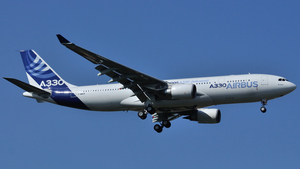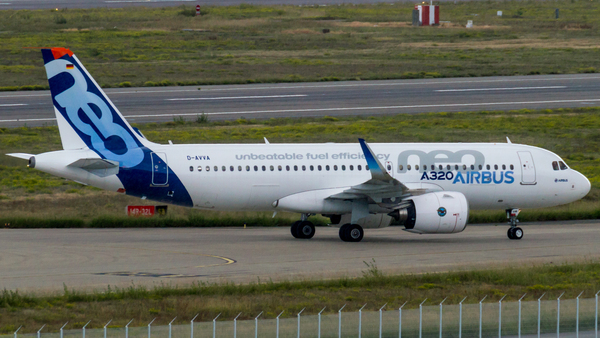EAT Leipzig B752 near Liege on Nov 3rd 2015, dropped engine access door in flight
Last Update: November 10, 2017 / 22:29:55 GMT/Zulu time
Incident Facts
Date of incident
Nov 3, 2015
Classification
Report
Airline
EAT Leipzig
Flight number
QY-121
Departure
Brussels, Belgium
Destination
Leipzig, Germany
Aircraft Registration
D-ALEF
Aircraft Type
Boeing 757-200
ICAO Type Designator
B752
On Nov 3rd 2015 the aircraft continued to fly a number of additional sectors. On Nov 4th 2015 the operator detected that a rear access door was missing from the right hand engine's thrust reverser. The part was replaced.
Some time in April 2016 a property owner, located about 6nm south of Liege Airport almost on the extended center line of the runway, discovered a part, looking like an aircraft part, in his garden. However, only 3 weeks later the property owner informed police, which prompted Belgium's Air Accident Investigation Unit (BAAIU) to open an investigation into the occurrence. The part was identified to be a rear thrust reverser access door of a Rolls Royce RB211-535C engine. The location of the garden prompted initial assumptions that the part was dropped by an aircraft operating into or out of Liege. This was the standing of the BAAIU's preliminary report, too.
Inquiries with Boeing and relevant operators identified a Boeing 757-200 operating for DHL (EAT Leipzig's D-ALEF) had been missing exactly that part on Nov 4th 2015. The aircraft had been operating Brussels-Leipzig on Nov 3rd 2015, departing Brussels at 01:33L (00:33Z) and passing about 2nm south of the garden at about FL200 (Editorial Note: upon detecting the final report, which still identifies - at the time of this summary - the occurrence aircraft flew Liege-Leipzig, The Aviation Herald issued an inquiry after being unable to match any (DHL/EAT) aircraft to the route provided in the initial report and on Oct 31st 2017 received a very favourable reply indicating that the investigation had indeed confirmed the aircraft flew Brussels-Leipzig but had accidentally not corrected the initial assumptions contained in the preliminary report, the final report is going to be updated).
Belgium's AAIU released their final report (updated Nov 10th 2017) into the incident concluding the probable causes were:
Cause
The release of the subject door assembly was due to separation of the forward hinge which occurred as a result of axial migration of the hinge pin on the TRU side of the hinge assembly. Migration of the hinge pin was due to a combination of in-service wear and insufficient pin retention, allowing the pin to migrate forwards and disengage completely.
Separation of the forward hinge allowed the door to dislodge into the airstream, with subsequent aerodynamic loading causing the rear hinge lugs to fracture in overload, releasing the door assembly.
Contributing factors:
The condition check of the hinges of the rear latch access door was not required by the Aircraft Maintenance Program.
With respect to the risk involved and classification as incident rather than serious incident the BAAIU analysed:
The mere consequence of a part falling from aircraft is usually not as dramatic. In Belgium, during the last 20 years, an average of two events are reported per year, usually in the vicinity of an airport and so far without any regrettable consequence. In most case, it concerns people finding an unusual object in their backyard and reporting it to the police. In some cases, the part itself does not originate from an aircraft.
The actual risk of falling aircraft parts causing injuries to persons cannot be precisely determined, but is believed to be very small and the result of:
- The frequency of parts falling off (in Belgium 2/year)
- The location where the parts are falling (the available data seem to indicate a concentration in the, usually less dense populated, vicinity of airports)
- The size and weight of the concerned aircraft part. (in average; panels and access panels are the most common parts falling from aircraft)
- The position of the part on aircraft, and the potential to cause damage to the aircraft.
- The density of population (Belgium: 363.6 people/km2 – third most densely populated European member state, higher in cities), however not everybody is out in the open all the time.
This event was initially classified as ‘serious incident’.
ICAO Annex 13 and EU996/2010 defines a ‘Serious Incident’ as “an incident involving circumstances indicating that there was a high probability of an accident and is associated with the operation of an aircraft (….)”
Therefore, the classification of this event was revised from ‘serious incident’ to ‘incident’.
The BAAIU analysed with respect to the sequence of events leading to the separation of the access door:
The inspection of the rear hinge assembly found that the hinge had separated due to complete fracture of the 2 butt hinge lugs on the thrust reverser side of the assembly.
The deformation in the fractured lugs was consistent with the access door being released at the forward hinge first and then being rotated downwards under aerodynamic loading, fracturing the lugs in overload.
Binocular examination of the fracture surfaces confirmed the lugs had fractured in overload with no evidence of propagated fracture.
The examination following hinge disassembly identified some wear to the pins and lugs but this was not considered significant enough to suggest the missing pin had worn through.
A closer examination of the forward door cut-out adjacent to the missing hinge pin identified evidence that the pin had migrated forwards.
This was most likely due to a combination of in-service wear and insufficient pin retention, allowing the pin to migrate forwards and disengage completely resulting in separation of the door at the forward hinge.
At all the other hinge pin locations the pins were baulked by the edges of the door cut-outs.
Boeing as well as the operator took safety actions to prevent repetition of the occurrence.
Incident Facts
Date of incident
Nov 3, 2015
Classification
Report
Airline
EAT Leipzig
Flight number
QY-121
Departure
Brussels, Belgium
Destination
Leipzig, Germany
Aircraft Registration
D-ALEF
Aircraft Type
Boeing 757-200
ICAO Type Designator
B752
This article is published under license from Avherald.com. © of text by Avherald.com.
Article source
You can read 2 more free articles without a subscription.
Subscribe now and continue reading without any limits!
Read unlimited articles and receive our daily update briefing. Gain better insights into what is happening in commercial aviation safety.
Send tip
Support AeroInside by sending a small tip amount.
Related articles
EAT Leipzig A306 at London on Oct 12th 2025, tail strike and balked landing
An EAT Leipzig Airbus A300-600 freighter on behalf of DHL, registration D-AEAG performing flight QY-2212 from Leipzig (Germany) to London Heathrow,EN…
EAT Leipzig A306 at Amsterdam on Oct 18th 2025, rejected takeoff due to bird strike
An EAT Leipzig Airbus A300-600 on behalf of DHL, registration D-AEAB performing flight QY-6731 from Amsterdam (Netherlands) to London Heathrow,EN…
EAT A306 at Leipzig on Feb 9th 2024, tail strike on go around
An EAT Leipzig Airbus A300-600 freighter, registration D-AZMO performing flight QY-995 from Tel Aviv (Israel) to Leipzig (Germany) with 2 crew, was…
EAT Leipzig A332 at Hong Kong on Nov 24th 2024, engine shut down in flight
An EAT Leipzig Airbus A330-200, registration D-ALOS performing flight QY-547 from Hong Kong (China) to Almaty (Kazakhstan), was climbing out of Hong…
EAT Leipzig A306 at Milan on Apr 5th 2024, loss of cabin pressure
An EAT Leipzig Airbus A300-600 freighter, registration D-AEAK performing flight QY-7022 from Milan Malpensa to Naples (Italy), was climbing through…
Newest articles
Southwest B737 at Cleveland on Oct 29th 2025, loss of separation with helicopter
A Southwest Airlines Boeing 737-700, registration N280WN performing flight WN-1333 from Baltimore,MD to Cleveland,OH (USA), was on final approach to…
Frontier A20N at New York on Oct 30th 2025, fuel leak, engine shut down in flight
A Frontier Airlines Airbus A320-200N, registration N394FR performing flight F9-3546 from San Juan (Puerto Rico) to New York JFK,NY (USA) with 152…
Subscribe today
Are you researching aviation incidents? Get access to AeroInside Insights, unlimited read access and receive the daily newsletter.
Pick your plan and subscribePartner

ELITE Simulation Solutions is a leading global provider of Flight Simulation Training Devices, IFR training software as well as flight controls and related services. Find out more.
SafetyScan Pro provides streamlined access to thousands of aviation accident reports. Tailored for your safety management efforts. Book your demo today
AeroInside Blog
Popular aircraft
Airbus A320Boeing 737-800
Boeing 737-800 MAX
Popular airlines
American AirlinesUnited
Delta
Air Canada
Lufthansa
British Airways








